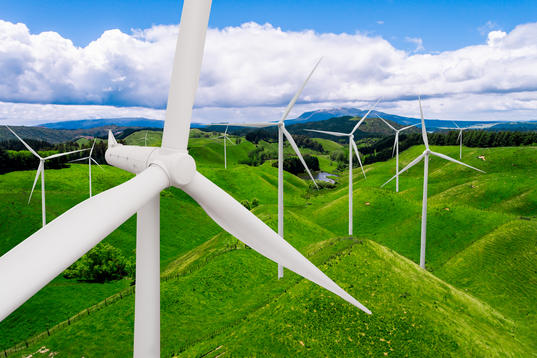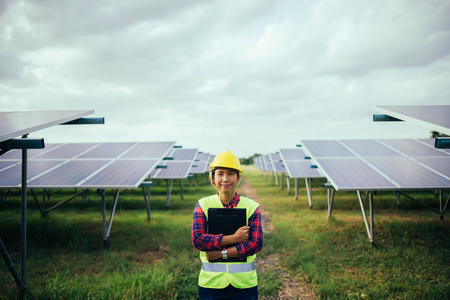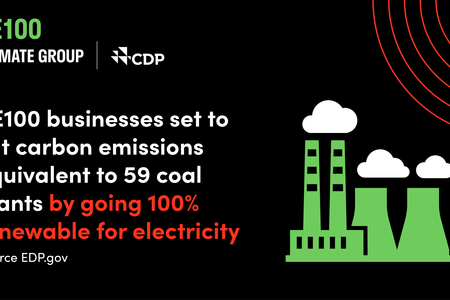RE100 hosted a webinar with RE100 members, PepsiCo and Salesforce, along with The Nature Conservancy and The National Audubon Society, to share examples of how corporate clean energy buyers can take action today to promote a clean and green future.
Guest blogger, Nathan Cummins, Great Plains Renewable Energy Strategy Director of The Nature Conservancy, details the importance of considering biodiversity and nature when building renewable infrastructure.
The global transition to clean energy must happen fast to meet climate goals. This will require an enormous buildout of renewable energy infrastructure around the world.
For example, according to the International Energy Agency’s Net Zero by 2050 Roadmap, humanity will have to install “the equivalent of the world’s largest solar park roughly every day” for the next 30 years to reach the emission reduction goals agreed to by scientific consensus.
This critical renewable energy build-out will require large areas of land for development. In the United States, Princeton University’s Net Zero America report estimates the renewable energy needed to achieve net-zero emissions by 2050 could require a footprint of 228,000 square miles—an area greater than the states of Wyoming and Colorado combined. This raises the potential for land-use challenges and negative impacts to both local communities and natural habitats.
But corporate renewable energy buyers can play a critical role in helping us avoid those conflicts, by shaping renewable energy markets and demonstrating leadership on the global stage through their ambitious renewable energy and sustainability commitments. The market pressure that leading corporate buyers can apply may well be the difference in how our clean energy transition hits the ground.
The good news is there’s an abundance of low-impact areas where the clean energy buildout can be advanced rapidly and in ways that benefits climate, communities, and nature. This is why the Climate Group hosted a webinar in summer 2021 with RE100 members, PepsiCo and Salesforce, along with The Nature Conservancy and The National Audubon Society, to share examples of how corporate clean energy buyers can take action today to promote a clean and green future.
RE100 is a global initiative, led by the Climate Group in partnership with CDP, within which over 340 major companies have made public commitments to procure 100% of their total electricity consumption from credible renewable sources and to transparently report on their progress along the way.
“Leading global companies know that the future of electricity is zero carbon, and that we must deploy holistic strategies for resilient growth which take nature and communities into account,” said Tessa Lee, Senior Corporate Engagement Manager at the Climate Group. “Committed corporates like Salesforce and PepsiCo have integrated sustainability throughout their business decisions, and are innovating at the leading edge of rapid decarbonization.”
These experts shared the following examples of what companies can do to help drive a clean and green transition.
The Nature Conservancy discussed how integrating environmental considerations early in the procurement process can deliver better projects by mitigating risks and increasing the climate and nature benefits these projects can offer to communities, such as cleaner air, water, and reuse of developed lands like brownfields. This is why The Nature Conservancy and the National Audubon Society are teaming up to drive a clean and green buildout of renewable energy under the Buy Renewables Right initiative.
“To meet ambitious clean energy goals, corporate buyers need clean energy to be developed rapidly. But to go fast the buildout will need to go smart—avoiding impacts to wildlife habitat and conflicts with communities,” said Bruce McKenney, Director of Energy & Infrastructure for The Nature Conservancy. When wind and solar projects avoid these problems, they are approved faster and at a lower cost. For example, a study of solar projects finds that permitting can be three times faster (13 vs. 35 months) and project costs 7 to 14 percent lower when projects are sited in areas of low biodiversity value.
In the webinar discussion, Salesforce shared how when they started their renewable energy buying journey, they realized that not all clean energy is created equal. Clean energy projects with the same transactional profile for cost and quantity can have very different impacts. Some projects displace more fossil fuel emissions than others, some are built in places that have greater impacts on wildlife habitat, and some provide more benefits for local communities and social equity. Given these important considerations, how can companies buy clean energy from the “best” projects to maximize the positive impact of their transition to clean energy?
To address this question, Salesforce developed a holistic approach to clean energy buying decisions that incorporates social and environmental considerations. “For us, purchasing RE is about more than adding new megawatts of renewable energy to the grid. It’s about improving the state of the world,” stated Megan Lorenzen, Sr. Manager, Sustainability for Salesforce. “The more buyers and investors ask these questions, the stronger the signal to the market. Hopefully, with a strong enough signal, the industry as a whole will shift, and we’ll eventually have to make fewer tradeoffs.” The Salesforce approach has inspired the launch of Beyond the Megawatt, a program of the Renewable Energy Buyers Alliance (REBA).
Learning from industry peers and NGO partners was critical for the success of PepsiCo’s renewable energy strategy, which the company launched in 2019. Ryan Spicer, Senior Manager of Sustainability at PepsiCo, provided learnings on how PepsiCo realized that the climate and biodiversity crises must be faced together. “Environmental stewardship is a core value of PepsiCo. When we were evaluating these long-term wind projects, utilizing resources like The Nature Conservancy’s Site Wind Right Map were critical to getting projects that met our climate and nature goals as company.”
Lastly, Garry George, Clean Energy Director at The National Audubon Society shared Audubon’s climate science reveals that 389 species of North American birds will be threatened with extinction if warming reaches 3 degrees Celsius over pre-industrial levels.
“Even holding warming to 1.5° Celsius (2.7° Fahrenheit) can save the places that both birds and people need to survive. To reach the ultimate goal of 100% clean energy and net zero emissions, utility-scale wind and solar projects need to be sited to avoid the important natural lands and habitats that birds need to adapt to climate change until the reductions in emissions and warming take place over time,” stated George. “Audubon supports siting wind and solar first and foremost on previously degraded low-impact lands where permitting can proceed faster, more efficiently and at less cost to ratepayers and the industry.”
The good news that we don’t need to sacrifice important habitat and carbon storage to rapidly develop clean energy. The world has an abundance of low-impact lands with high renewable energy development potential—exponentially more than what is needed to meet the world’s clean energy demands. Companies can advance goals for renewable electricity, climate, and biodiversity simultaneously by committing not to buy renewable energy from projects that harm important natural areas. Conserving these places and wildlife is a win-win-win for climate, nature, and consumers.
If you would like to get access to the webinar recording, please contact info@re100.org



